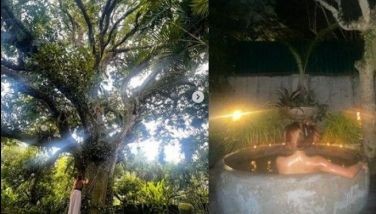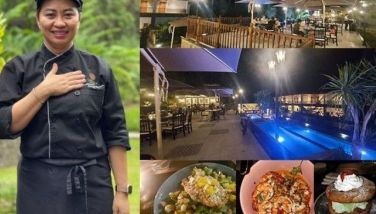I backpacked in Japan and was saved by Filipinos
MANILA, Philippines - Magome, a small, old post town 102 kilometers northeast of Nagoya, was the order of the day. From there, the plan was to trek almost eight kilometers of roads and trails to Tsumago, another preserved post town. My two siblings and I were in Japan for the first time for a short four-day, five-night backpacking trip, and Typhoon Phanfone (Typhoon Neneng in the Philippines) was forcing itself into our plans.
We woke up at 6 a.m. to pack our bags, hoping to board the train at 7:30 a.m., only to be welcomed at the station with the announcement that all trains, including the Shinkansen bullet train, were at a halt. We braved the storm to walk seven blocks from our dingy traveler’s inn (named Nagoya Guesthouse Otohaya) our umbrellas turning inside out with every burst of Phanfone’s winds, and were promptly stunned by the sign flashing in red on the TV screens mounted all over the station. It was purely in Japanese, so we couldn’t understand. But the message was clear to us. People in black and white coats and ties stood still behind the turnstile, arranged like uneven keys of an old, detuned piano. Until that moment, there were two things we never thought happened in first world Japan: its working men and women staying put at a train station, and the trains refusing to run. The Philippines wasn’t so far behind after all.
It was Sunday the day before and we went to Mass at Mikokoro Center (or Sacred Heart Center) to pray for a smooth trip amid the typhoon rocking the city. The attendees were mostly Filipino OFWs and immigrants, and the singing group itself was made up of your typical titos and titas who were even more animated than your local community’s children’s choir.
When we approached them after Mass to ask what places they’d recommend us to visit, the group’s conductor joked, “Akala ko, sasabihan mo kaming ampangit naming kumanta, eh!” We laughed, and after we introduced ourselves to each other — where we were staying and what we were there for — we talked to them about what we wanted to see. They pointed us to the usual Nagoya Castle (“Walking distance lang!”) but the rains made it an unwelcome destination. They offered us pancit for lunch — “a taste of home,” they said — but we politely refused as we thought their hospitality had been more than enough. We hadn’t talked long enough to merit any profound closeness or any companionship. But I guess, along with the comforts faith brought, warmth came in knowing that even just for an hour, we were with the same folk that made our home and that it wouldn’t be hard to find them should we lose our way in the city.
Marooned by storm
But the next day at the train station, we were marooned, our plans ruined by the storm. It was a Monday and all of Nagoya’s museums were closed, save for the Nagoya Castle. And except for us gaijins, everyone was expected to be at work. The feeling of being stuck was similar to feeling lost except that choices weren’t ours to make. But as soon as we stepped out of the subway station, the sun was up. It did not mean, however, that the trains would start running again. The people at the information desk said that the trains would resume operation at 12 noon and you could trust the Japanese to honor their commitments with time.
We had two hours before the trains resumed operations so we decided to push through to Nagoya Castle. Under clear skies, it was an awe-inspiring place not only for its size and architecture, but for the lengths the Japanese went to restore the castle to its original state. The Nagoya Castle had suffered time’s torments and heavy bombing in the Second World War. There were, however, no big corporate sponsors placing ads in unscrupulous corners and taking credit for its restoration, only a quiet government initiative to simply preserve the heritage site. The sights and readings made us want to go to Magome even more. It is said that the Emperor often stopped over at Magome whenever he made a trip south to Kyoto from Tokyo. There, on a mountain’s ridgeline, he would rest and regroup his samurais. That was where we wanted to go.
At 3 p.m., we were back in our 2.5 x 9 meter hostel room after a quick lunch at the Osu Kannon Temple area. We were bummed that we had nowhere left to go except Nagoya’s shopping district and we weren’t exactly ones to shop. Magome seemed to be an impossibility. But for a moment, a wild thought got into our heads: Why don’t we spend the night in Magome?
We checked online for hostels in Magome and canvassed. It would cost us roughly P2,500 per person to spend the night there. It was a fair price. Heck, we weren’t going to be in this neck of the woods for long. We packed our overnight clothes and toiletries and ran straight to train station to catch the last two-hour train at 4 p.m. to Nakatsugawa, where the last bus would take us to Magome at 6:30 p.m. It was a photo finish entry to the train with the lady manning the platform entrance barely understanding our question: “How long is the train ride to Nakatsugawa?” to which she replied, “Now!”
Smooth and steady trip
It was a smooth and speedy trip to Nakatsugawa with Japan’s rural towns and mountainsides completing the Kiso Valley scenery outside our train’s windows. Upon disembarking the train, we got on the bus that stopped around a dozen stations before reaching Magome. It shut its doors quickly and turned around to Nakatsugawa once it unloaded us in Magome’s bus station. At 7:30 p.m., the town was fast asleep. Soon, we felt like we were characters in some segment of Shake, Rattle, and Roll XIII: Japan Edition.
The town was a one-street town with a few lamps lighted outside the old houses. All doors were closed and there was nary a room in sight with anything going on. I saw a pair of feet when I peeped through a small window panel and we immediately knocked to ask for help. She was talking in a language we couldn’t understand. Panicking, we motioned for sleep, acting out different variations of persons sleeping and posing like roofs and beds while saying out loud, “Place… to… sleep… hostel?” We realized how stupid we were for not bothering to check what those words were in Nihongo before leaving our hostel in Nagoya. But she kept pointing to the moon (which was almost full that night) and we assumed she meant, “It’s very late!”
She led us to the first hostel but the man in charge wouldn’t let us in. “Closed!” he said, while making an “X” with his arms. He brought a cordless phone with him and we assumed that he was calling the next hostel. It was around 8 p.m. and at this point, I was pondering how long it would take us if we walked the cold and dark 20 kilometers down the mountain. After their conversation, nonetheless, we were led up to the next hostel. A tall, healthy-looking man talked to us outside this second hostel and we replied with a repeat performance of “Place… to… sleep?” But he just silently went back in, behind the canvas sign. His wife walked to the entrance and peeked underneath the canvas. She asked us, “Filipino?”
We said yes, and when she showed her face, she said, “Kabayan niyo ‘ko,” to which we rejoiced, “Filipino!” Until then, I had never felt so happy to be a Filipino in a different country, in a sleepy rural province, far away from the city center.
“Ate Cheng”
Her name was Cheng Hasegawa, we called her “Ate Cheng,” and she welcomed us into their ryokan or traditional Japanese hotel, Magomechaya, where the floors were made of tatami and the stone-walled bathrooms were a sit-down affair with other guests. We were provided with kimonos for the night and she assigned us to a room that could, perhaps, fit two more persons. She cooked us authentic yakisoba while we read recent copies of Wired magazine and The New Yorker at the common area. Our luck was, on all counts, spectacular.
We talked for hours about our lives and their lives in Japan. She told us that she had been there for more than a decade and that she and her husband just recently had a son, Ken (as in Ken Hirai, the pop star). She told us that she had been managing her husband’s inherited business and that she had grown it herself for years now, adopting new ways of marketing the place. She said that she had brought their son to her parents in the Philippines so he would be looked after properly, so that the business would also run smoothly. She said that life in Japan has been kind but not easy. And while her husband turned to the Japanese God for business that resided in Okinawa, Japan, her faith remained strong in the Mother of Perpetual Help in Laguna.
At the very least, it comforted us that we didn’t need to play one bit of Charades to communicate and that we didn’t have to sleep out in the cold. But at the heart of it, we were just grateful that Ate Cheng took us in. It is a known fact that, above all, it is OFW remittances — the Filipino diaspora — that has been keeping our economy afloat. But being saved in the way that she did was something we never expected.
We left for Tsumago the next morning not without Ate Cheng feeding us a full breakfast of sukiya gyudon, teaching us some useful Japanese phrases, and even giving us pieces of chinaware “to bring home to our mom.”
* * *
Feel free to book your stay in Magomechaya by emailing [email protected]. Tweet the author @sarhentosilly.
- Latest
- Trending




















 Exclusive
Exclusive






